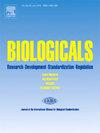Vaccination and surveillance for high pathogenicity avian influenza in poultry—current situation and perspectives
IF 1.5
4区 生物学
Q4 BIOCHEMICAL RESEARCH METHODS
引用次数: 0
Abstract
The International Alliance for Biological Standardization (IABS), in collaboration with the World Organization for Animal Health (WOAH) convened a hybrid meeting on 22–23 October 2024 at the WOAH Headquarters (HQ) in Paris, France to discuss the global state of vaccination and surveillance for high pathogenicity avian influenza (HPAI) in poultry. The primary objective of the meeting was to advance vaccination acceptance to both control virus spread and reduce disease. Vaccination is increasingly recognized as a tool to complement biosecurity, movement controls and stamping-out of infected flocks. However, concerns persist regarding the risk of undetected, sustained transmission (silent infection) in vaccinated flocks as a result of inadequate surveillance. This has contributed to both vaccination hesitancy and trade barriers. The meeting aimed to assess the current state of the art regarding HPAI surveillance programs in vaccinated populations and their effectiveness. Representatives of multiple stakeholders were invited to share their experiences and perspectives on the use of vaccination and accompanying surveillance to control the growing H5N1 panzootic and its global impact. Several conclusions and recommendations emerged as essential to advancing the acceptance of vaccination strategies. These included (1) the utility of quantitative reverse transcriptase polymerase chain reaction (RT-qPCR) as a sensitive, specific and economical tool to detect virus in vaccinated populations, (2) regular testing of dead birds within a flock as a highly effective method for early detection of outbreaks in vaccinated flocks and demonstrating freedom from infection and, (3) the importance of collecting information on circulating field strains in the selection of candidate vaccine antigens to ensure adequate efficacy. Testing sentinel birds was deemed less effective for surveillance and serological testing of vaccinated birds was considered more useful for assessing immunity levels than for determining the infection status of a flock. There was broad agreement on the need to standardize surveillance outcomes in terms of accepted confidence levels to promote safe and fair trade. However, it was acknowledged that context and pragmatic considerations will shape the development of situation specific plans, which must be statistically valid, scientifically sound, economically feasible and operationally sustainable for both governments and industry. Concomitantly, it was recommended that trade policies tied to vaccination and surveillance should be based solely on science and risks. To this end, enforcement of existing international rules and resolution of disputes are considered a shared responsibility. Peer reviewed publications were proposed as a central mechanism for developing the stronger guidelines needed to facilitate fair trade agreements and enable implementation of global vaccination programs. Rapid dissemination of information, consistent messaging and exchange of virus isolates were also seen as critical for coordinating an effective global response to controlling HPAI.
家禽高致病性禽流感的疫苗接种和监测——现状和展望
国际生物标准化联盟(IABS)与世界动物卫生组织(WOAH)合作,于2024年10月22日至23日在法国巴黎的世界动物卫生组织总部召开了一次混合会议,讨论全球家禽高致病性禽流感(HPAI)疫苗接种和监测状况。会议的主要目标是促进疫苗接种的接受,以控制病毒传播和减少疾病。人们日益认识到,疫苗接种是补充生物安全、移动控制和消灭受感染禽群的一种工具。然而,由于监测不足,在接种疫苗的鸡群中存在未被发现、持续传播(隐性感染)的风险,这一点仍然令人担忧。这造成了对疫苗接种的犹豫和贸易壁垒。会议旨在评估在接种疫苗人群中进行高致病性禽流感监测规划的现状及其有效性。多个利益攸关方的代表应邀就利用疫苗接种和伴随的监测来控制日益增长的H5N1大流行性疾病及其全球影响分享了他们的经验和观点。一些结论和建议对于促进疫苗接种战略的接受至关重要。其中包括(1)定量逆转录酶聚合酶链反应(RT-qPCR)作为一种敏感、特异和经济的工具,在接种疫苗的人群中检测病毒;(2)定期检测禽群中的死鸟,作为一种高效的方法,早期发现接种疫苗的禽群中的疫情,并证明其不受感染;(3)收集流行野毒株信息对选择候选疫苗抗原以确保足够的效力的重要性。对哨点禽类进行检测被认为在监测方面效果较差,对接种疫苗的禽类进行血清学检测被认为在评估免疫水平方面比在确定禽类感染状况方面更有用。与会者广泛同意有必要根据可接受的信任水平将监测结果标准化,以促进安全和公平的贸易。但是,会议承认,根据具体情况制定的计划必须在统计上有效、在科学上合理、在经济上可行、在操作上对政府和工业界都是可持续的。同时,建议与疫苗接种和监测有关的贸易政策应完全基于科学和风险。为此目的,执行现有的国际规则和解决争端被认为是共同的责任。同行评议出版物被提议作为制定促进公平贸易协定和实施全球疫苗接种计划所需的更强有力的指导方针的核心机制。迅速传播信息、一致传递信息和交换病毒分离物也被视为协调有效的全球应对措施以控制高致病性禽流感的关键。
本文章由计算机程序翻译,如有差异,请以英文原文为准。
求助全文
约1分钟内获得全文
求助全文
来源期刊

Biologicals
生物-生化研究方法
CiteScore
3.70
自引率
0.00%
发文量
39
审稿时长
48 days
期刊介绍:
Biologicals provides a modern and multidisciplinary international forum for news, debate, and original research on all aspects of biologicals used in human and veterinary medicine. The journal publishes original papers, reviews, and letters relevant to the development, production, quality control, and standardization of biological derived from both novel and established biotechnologies. Special issues are produced to reflect topics of particular international interest and concern.Three types of papers are welcome: original research reports, short papers, and review articles. The journal will also publish comments and letters to the editor, book reviews, meeting reports and information on regulatory issues.
 求助内容:
求助内容: 应助结果提醒方式:
应助结果提醒方式:


